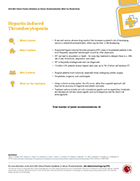ASH VTE Guidelines: Heparin-Induced Thrombocytopenia (HIT)
In February 2022, these guidelines were reviewed by an expert work group convened by ASH. Review included limited searches for new evidence and discussion of the search results. Following this review, the ASH Committee on Quality agreed to continue monitoring the supporting evidence rather than revise or retire these guidelines at this time. Limited searches and expert review will be repeated annually going forward until these guidelines are revised or retired. Derivative resources will be updated accordingly.
Heparin-Induced Thrombocytopenia (HIT) is a prothrombotic adverse drug reaction. One third to one-half of cases of HIT are complicated by thrombosis, which may be limb- or life-threatening. Recommendations address screening of asymptomatic patients for HIT, diagnosis and initial management of patients with suspected HIT, treatment of acute HIT, and special situations in patients with acute HIT or a history of HIT, including cardiovascular surgery, percutaneous cardiovascular intervention (PCI), renal replacement therapy, and VTE prophylaxis.
Access the full guidelines on the Blood Advances website:
Guideline Implementation Tools and Resources
ASH guidelines are reviewed annually by expert work groups convened by ASH. Resources derived from guidelines that require updating are removed from the ASH website.
A snapshot of these guidelines is also available as a PDF.
VTE Guidelines: What You Should Know
This one-page snapshot provides a high-level summary of the guidelines on HIT, a rare and serious adverse drug reaction that increases a patient’s risk of developing venous or arterial thromboembolism. A snapshot of the full VTE guidelines is also available for download.
ASH Clinical Practice Guidelines App
The ASH Clinical Practice Guidelines App provides easy access to every recommendation from all guidelines published by ASH, including rationale for each recommendation, benefits and harms associated with each recommended course of action, and links to the complete evidence-to-decision tables used to develop the recommendations. This app is also available via web interface.
Download for iOS Download for Android
Pocket Guides
Available on iOS, Android, and via the web, the ASH Pocket Guides App includes all of ASH’s pocket guides, including the 2018 pocket guide on the Diagnosis and Management of Heparin-Induced Thrombocytopenia (HIT), which is available for order in printed format at the ASH Store.
- Diagnosis and Management of Heparin-Induced Thrombocytopenia (HIT)
ASH Store | Download PDF - not for distribution
Teaching Slides
Help your colleagues diagnose, manage, and treat heparin-induced thrombocytopenia with the following teaching slides designed for easy dissemination:
- Teaching slides for heparin-induced thrombocytopenia
Powerpoint | PDF
Podcast
Listen to the podcasts below to learn more about ASH's HIT guidelines.
VTE Patient Stories

Stephen Rodner, a retired attorney from New Jersey, experienced venous thromboembolism (VTE) around 12 years ago. He noticed a pain in his leg but chalked it up to something he did at the gym. A couple of weeks passed by and the pain remained.
One day while watching TV at the gym, Stephen watched a news report that Dick Cheney was diagnosed with deep-vein thrombosis (DVT), a blood clot that forms in the deep veins, after an overseas trip. “I thought it looked like what I might have,” said Stephen. Dick Chaney’s story, plus the insistence of his wife, gave Stephen the final nudge to visit his doctor. Stephen’s doctor took one look at the leg and called a radiologist, who diagnosed Stephen with DVT.
A series of blood tests were conducted and it was discovered that Stephen had thrombophilia, a condition in which the blood is more likely to clot. Stephen was put on a blood thinner.
Since his experience with DVT, Stephen’s quality of life has not changed much. He continues to take his medicine and hasn’t experienced another blood clot. Because he is taking blood thinners, Stephen wears a medical alert bracelet, just in case.
Stephen served for eight years on the board of the National Blood Clot Alliance to educate people about the signs and symptoms of VTE. “It’s important for people to know what factors would put them at high risk. This is a real issue, and a lot of serious problems can be prevented by people knowing about it,” Stephen said.
Patient Versions of the Guidelines
- Blood clots when you are pregnant or breastfeeding
- Heparin-induced thrombocytopenia
- Preventing a blood clot
- Testing for blood clots
- Things to know if you are taking a blood thinner to prevent blood clots
